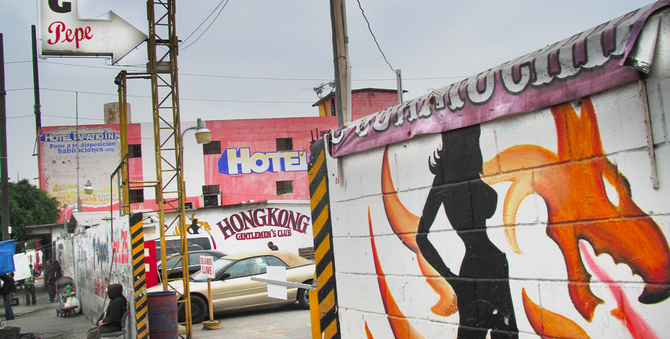 Facebook
Facebook
 X
X
 Instagram
Instagram
 TikTok
TikTok
 Youtube
Youtube

At 9 p.m. on Tuesday, October 30, at the corner of Coahuila and Niños Héroes, the area was crowded with people grabbing quick food from the taco carts.
At first it sounded like firecrackers. After a few more shots you could tell that the sounds were coming from different sides of the street. The uneven rhythm of the shots and the fact that one person was carrying a much bigger weapon than the other made it clear what was happening.
Suddenly, people started dropping to the ground or running for cover, careful not to drop their tacos. The shooting stopped, tires squealed, and one could sense that it was safe to stand up. I was slow to react; it was my first Tijuana drive-by.

Two men were down, both apparently shot in the mid-section. One man lay in the street moving as another man held a towel tightly to his left side. Blood was starting to pool underneath him. The man on the sidewalk seemed much worse off: no movement.
A rumor started to circulate that the wounded were undercover Tijuana officers. Within minutes, state police pickups were on the scene, sirens blasting; municipal police pickups, cars, and motorcycles, also. Then the unmarked pickups, lights strobing from concealed spots in the grille.
Officers were jumping out of the pickups and running down the street to the scene of the firefight. The speed of the response and the number of responders lent some credibility to the rumor. Tijuana police look out for each other, and they do so armed to the teeth. The shooters were probably long gone, but it still seemed prudent to leave the area where adrenaline was about to mix with high-power automatic weapons.
For the most part, the drug-war violence has been concentrated in the eastern part of Tijuana. This is downtown Tijuana, Zona Norte, a few minutes’ walk to the busiest land border crossing in the world.
Click here for K. Mennem's initial report on the shooting.


At 9 p.m. on Tuesday, October 30, at the corner of Coahuila and Niños Héroes, the area was crowded with people grabbing quick food from the taco carts.
At first it sounded like firecrackers. After a few more shots you could tell that the sounds were coming from different sides of the street. The uneven rhythm of the shots and the fact that one person was carrying a much bigger weapon than the other made it clear what was happening.
Suddenly, people started dropping to the ground or running for cover, careful not to drop their tacos. The shooting stopped, tires squealed, and one could sense that it was safe to stand up. I was slow to react; it was my first Tijuana drive-by.

Two men were down, both apparently shot in the mid-section. One man lay in the street moving as another man held a towel tightly to his left side. Blood was starting to pool underneath him. The man on the sidewalk seemed much worse off: no movement.
A rumor started to circulate that the wounded were undercover Tijuana officers. Within minutes, state police pickups were on the scene, sirens blasting; municipal police pickups, cars, and motorcycles, also. Then the unmarked pickups, lights strobing from concealed spots in the grille.
Officers were jumping out of the pickups and running down the street to the scene of the firefight. The speed of the response and the number of responders lent some credibility to the rumor. Tijuana police look out for each other, and they do so armed to the teeth. The shooters were probably long gone, but it still seemed prudent to leave the area where adrenaline was about to mix with high-power automatic weapons.
For the most part, the drug-war violence has been concentrated in the eastern part of Tijuana. This is downtown Tijuana, Zona Norte, a few minutes’ walk to the busiest land border crossing in the world.
Click here for K. Mennem's initial report on the shooting.
Comments